The device is also equipped with an infrared light-emitting source with a variable gain control. It has a magnification of 1× or 3× with an optional magnifier. The AN/PVS-14 amplifies available ambient star, moon, or reflected light to produce an intensified image in the proper perspective.
AN/PAS-13 Medium/Heavy Weapon Thermal Sight
The AN/PAS-13 (V2) medium weapon thermal sight (MWTS) and the AN/PAS-13 (V3) heavy weapon thermal sight (HWTS) are silent, lightweight, compact, and durable battery-powered infrared-imaging sensors that operate with low battery consumption. The MWTS has a 3.3× magnification and the HWTS has a 10× magnification. When firing your weapon with either WTS, the fundamentals of marksmanship are the same as with each weapon system using the AN/PVS-4, minus certain techniques for the M203 and M2 HB .50-caliber.

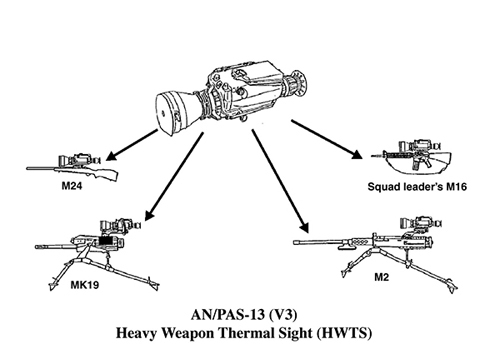
AN/TVS-5 NVD
The AN/TVS-5 is a portable, battery-operated electro-optical instrument used for observation and aimed fire of weapons at night. It amplifies reflected light such as moonlight, starlight, and sky glow so that the viewed scene becomes clearly visible to the operator. The only two weapons that use the AN/TVS-5 are the M2 HB .50-caliber machine gun and the MK19 grenade launcher. By using this device, the gunner can observe the area and detect and engage any suitable target. It has a magnification: 5.6× and range of 1,000 to 1,200 meters for vehicle targets (under ideal conditions).
AN/PVS-10 Night Vision Sniper Scope
The AN/PVS-10 night vision sniper scope, referred to as the sniper night scope (SNS), is an integrated weapon sight that provides both day and night operation in a single sight. The M3A scope is the primary day sight that snipers employ and all sniper marksmanship training is based on this. The scope has an effective range of 800 meters during the day and 600 meters at night.
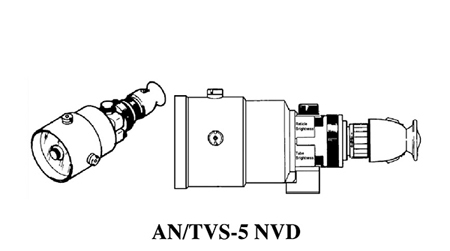
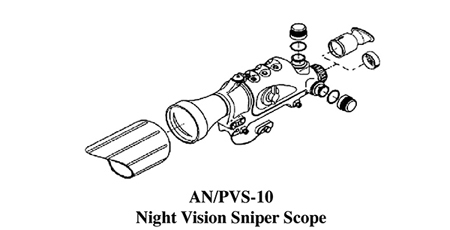
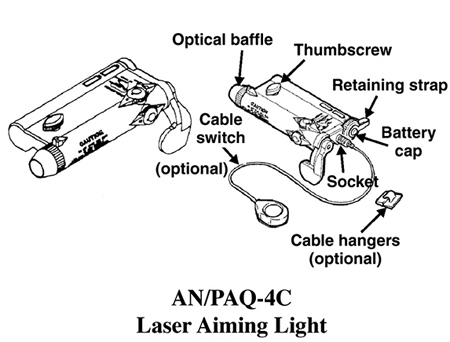
AN/PAQ-4C Laser Aiming Light
The AN/PAQ-4C aiming light projects an infrared laser beam that cannot be seen with the eye but can be seen with NVDs. This aiming light works with the AN/PVS-7B/D series goggles and AN/PVS-14. The AN/PAQ-4C mounts on various weapons with mounting brackets and adapters. It has a range of 600 meters or beyond, dependent on the light level and NVD used for observation.
AN/PEQ-2A Laser Aiming Light
The AN/PEQ-2A is a Class IIIb laser that emits a highly collimated beam of infrared light for precise aiming of the weapon, as well as a separate infrared illumination beam with adjustable focus. Both beams can be zeroed to the weapon and each other, and can be operated individually or in combination. The AN/PEQ-2A is for use in conjunction with NVDs and can be used as either a handheld illuminator/pointer or weapon mounted with included brackets and accessory mounts. In weapon-mounted mode, the AN/PEQ-2A can be used to accurately direct fire as well as to illuminate and designate areas and targets.
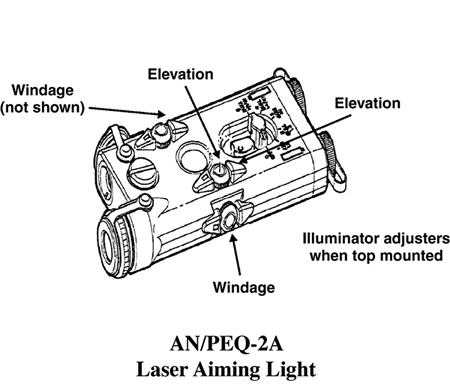
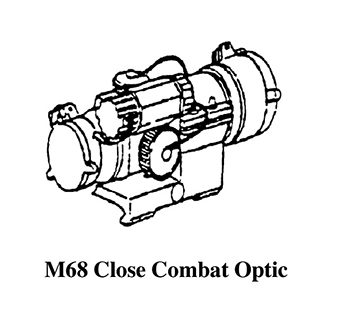
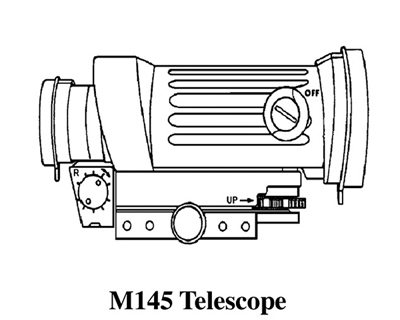
M68 Close Combat Optic
The M68 Close Combat Optic (CCO) sight is a reflex (nontelescopic) sight. It uses a red aiming reference (collimated dot) and is designed for use with both eyes open. At ranges beyond 50 meters, the red dot remains fixed on the target no matter what angle is used, and the gunner fires at the target. No centering is required. The best ranges fall between close combat and 300 meters.
M145 Telescope
The M145 telescope is a fixed 3.4×, 28mm optical sight designed to engage targets accurately out to 1,200 meters. The optical sight weighs 24 ounces, is extremely rugged, has excellent vision in low light levels, and provides for rapid target acquisition. The M145 straight telescope mounts directly to the mounting rail on the M249 and M240B machine guns.
17
Nuclear, Biological, and Chemical (NBC) Warfare
NBC weapons can cause casualties, destroy or disable equipment, restrict the use of terrain, and disrupt operations. The infantry platoon must be prepared to operate on an NBC-contaminated battlefield without degradation of the platoon’s overall effectiveness.
CHEMICAL AGENTS
Chemical agents can cover large areas and may be delivered as a liquid, vapor, or aerosol. They can be disseminated by artillery, mortars, rockets, missiles, aircraft spray, bombs, land mines, and covert means. The following table provides the characteristics of and treatment for exposure to chemical agents.
BIOLOGICAL AGENTS
Protective measures against biological attack include up-to-date immunizations, good hygiene, area sanitation, physical conditioning, and water purification. Toxins and pathogens are the two types of biological agents. Toxins are poisonous substances produced from living organisms. They can be synthesized (artificially produced) and can mirror the symptoms of nerve agents. They are destroyed by the sun after about eight to twelve hours. Pathogens are infectious agents such as bacteria, viruses, and rickettsiae that cause disease in man and animals. Pathogens have a delayed reaction (incubation from one to twenty-one days) and can multiply and overcome natural defenses. When used in vectors (disease-infected insects), they can circumvent protective clothing and prolong hazards.
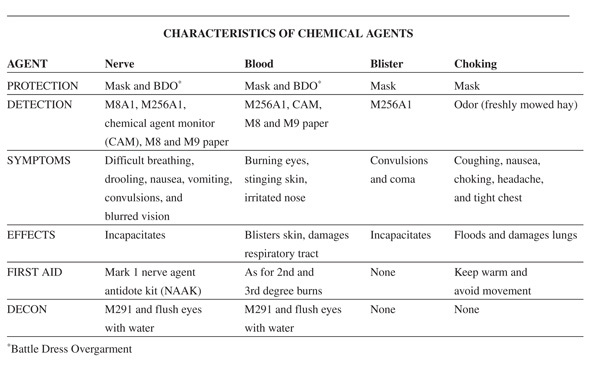
NUCLEAR WEAPONS
Soldiers should also know the effects of nuclear explosions—even accidental ones—and how to protect themselves from the effects of nuclear detonations. The three principal effects of a nuclear weapon detonation are blast, radiation, and electromagnetic pulse. Blast is the high-pressure shock wave that crushes structures and causes missiling damage. Thermal radiation is the intense heat and extremely bright light that cause burns, temporary blindness, and dazzle. Nuclear radiation is energy released from the detonation that produces fallout in the forms of initial and residual radiation, both of which can cause casualties. An electromagnetic pulse is the surge of electrical power that occurs within seconds of a nuclear detonation and damages electrical components in equipment (radios, radar, computers, and vehicles) and weapons systems (TOWs and Javelins).
Cover and or shielding offers the best protection from the immediate effects of a nuclear attack. This includes cover in fighting positions, culverts, and ditches. Soldiers should cover exposed skin and stay down until the blast wave passes and debris stops falling. Immediately after a nuclear attack, the platoon leader should begin continuous monitoring for radiation using the AN/VDR-2 radiacmeter.
TENETS OF NBC DEFENSE
Contamination Avoidance
Avoidance allows commanders to shield soldiers and units, thus shaping the battlefield. It involves both active and passive measures. Active measures include detection, reconnaissance, alarms and signals, warning and reporting, marking, and contamination control. Passive measures include training, camouflage, concealment, hardening positions, and dispersion.